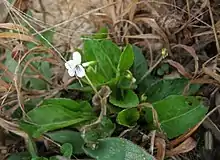Viola primulifolia
Viola primulifolia, commonly called the primrose-leaf violet,[1] is a species of flowering plant in the violet family. It is native to eastern North America,[2] and possibly also to the Pacific Northwest.[3] Its natural habitat is wet acidic areas that are usually at least semi-open.[4]
| Viola primulifolia | |
|---|---|
 | |
| Scientific classification | |
| Kingdom: | Plantae |
| Clade: | Tracheophytes |
| Clade: | Angiosperms |
| Clade: | Eudicots |
| Clade: | Rosids |
| Order: | Malpighiales |
| Family: | Violaceae |
| Genus: | Viola |
| Species: | V. primulifolia |
| Binomial name | |
| Viola primulifolia | |
It is a low, stemless perennial that produces white flowers in the spring.[5] It can be distinguished from the similar-looking Viola lanceolata and Viola blanda by its leaves that are ovate, with rounded to truncate bases, and are 1.5-2 times as long as wide.[4]
While typical Viola primulifolia occurs in a large area of the east, a variety of this species is sometimes credited to occur in a small area of western California and Oregon, under the name of V. primulifolia var. occidentalis.[6] These populations, which are considered rare and highly localized, have alternatively been referred to as Viola lanceolata ssp. occidentalis.[7]
References
- Flora of the Southern and Mid-Atlantic States
- "Viola primulifolia". County-level distribution map from the North American Plant Atlas (NAPA). Biota of North America Program (BONAP). 2014. Retrieved 5 August 2017.
- Flora of North America
- Chester, Edward (2015). Guide to the Vascular Plants of Tennessee.
- IllinoisWildflowers
- Calflora
- PLANTS Profile for Viola lanceolata occidentalis Retrieved 2017-08-05